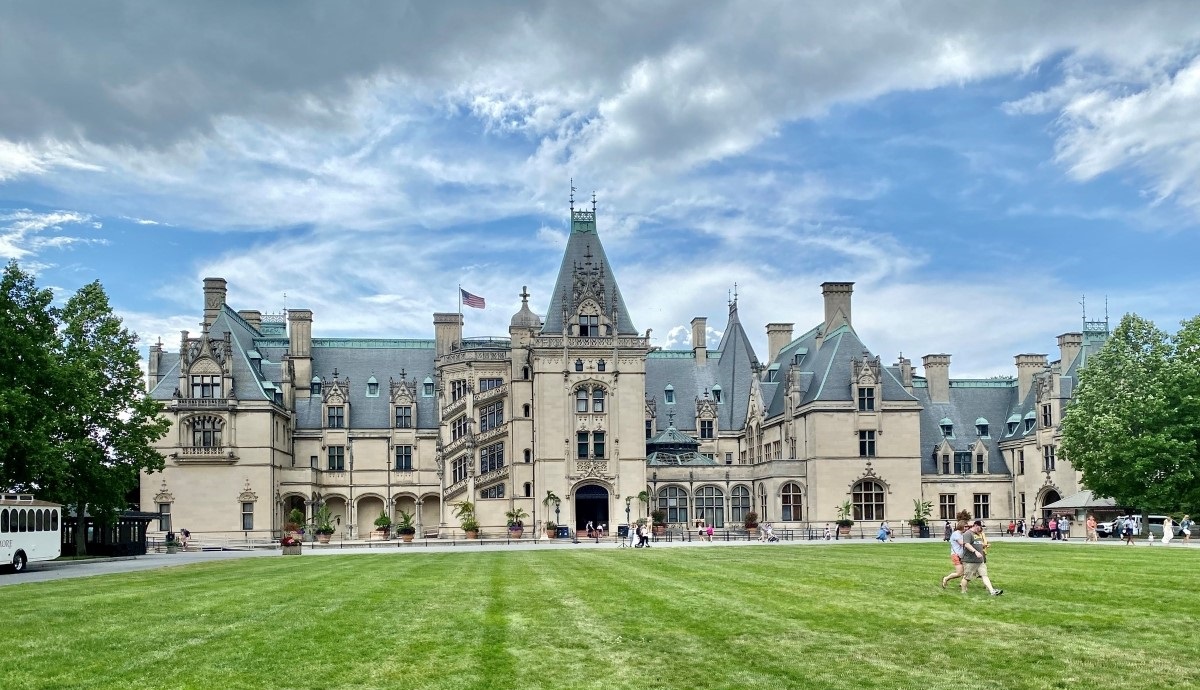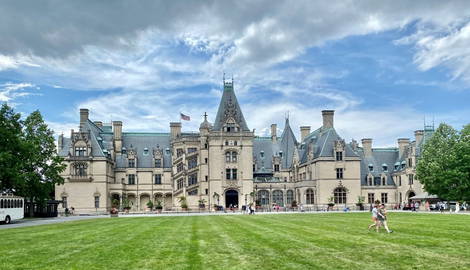
Originally part of the Carolina Colony granted by King Charles II in 1663, North Carolina became a separate province in 1712 and one of the original thirteen colonies. In 1776, it made history by being the first colony to officially call for independence through the Halifax Resolves. During the Civil War, it was the site of major surrenders that helped bring the conflict to a close. The state also played a key role in the advancement of public education and the early tobacco industry. Today, this rich legacy is preserved across North Carolina in historic buildings, memorials, and cultural institutions that continue to tell the story of rebellion, resilience, and reinvention. Here are ten must-see historic sites in the Tar Heel State.
1. Biltmore Estate, Asheville

Nestled in Asheville, the Biltmore Estate stands as America’s largest privately owned home, a testament to Gilded Age grandeur. Commissioned by George Washington Vanderbilt II, construction began in 1889 and culminated in 1895. The 175,000-square-foot Châteauesque mansion boasts 250 rooms, including 35 bedrooms, 43 bathrooms, and 65 fireplaces.
Visitors can explore the opulent interiors, featuring a vast library with over 10,000 volumes, a banquet hall adorned with a 70-foot ceiling, and a basement equipped with a bowling alley and indoor pool. The estate’s 8,000 acres encompass meticulously landscaped gardens designed by Frederick Law Olmsted, offering seasonal floral displays and tranquil walking paths.
Beyond the main house, Antler Hill Village provides a glimpse into the estate’s agricultural history, complete with a working farm and the Biltmore Winery, where guests can enjoy complimentary tastings. Seasonal events, such as the “Biltmore Blooms” in spring and festive holiday decorations in winter, enhance the visitor experience.
2. Wright Brothers National Memorial, Kill Devil Hills

Perched atop the windswept dunes of Kill Devil Hills, the Wright Brothers National Memorial marks the birthplace of powered flight. On December 17, 1903, Orville and Wilbur Wright achieved the first controlled, sustained flight of a heavier-than-air machine, forever altering human history.
The memorial’s centerpiece is a 60-foot granite monument, dedicated in 1932, standing atop the 90-foot Kill Devil Hill. This hill, once a shifting sand dune, was stabilized to honor the brothers’ numerous glider tests conducted here. The monument bears the inscription: “In commemoration of the conquest of the air by the brothers Wilbur and Orville Wright conceived by genius achieved by dauntless resolution and unconquerable faith.”
When visiting, you can explore reconstructed replicas of the Wrights’ 1903 camp buildings, including their hangar and living quarters. Markers along the flight path trace the distances of their four successful flights on that historic day. The visitor center houses exhibits featuring models, tools, and a life-size replica of the 1903 Wright Flyer, offering insights into the brothers’ innovative experiments.
3. Historic Bath, Beaufort County

In 1705, Bath became North Carolina’s first incorporated town, strategically located along the Pamlico River. Its early years were marked by political intrigue, piracy, and conflict with Native American tribes. Notably, the infamous pirate Blackbeard, also known as Edward Teach, resided here briefly in 1718.
Today, Historic Bath offers visitors a glimpse into colonial life. Key sites include the Palmer-Marsh House (circa 1751), a National Historic Landmark that once served as both a residence and a commercial space, and the Bonner House (circa 1830), which showcases 19th-century domestic life.
St. Thomas Episcopal Church, constructed in 1734, stands as the oldest existing church in North Carolina. Visitors can also explore the Van der Veer House and the Exhibit Center, which provide further insights into the town’s rich history.
4. Old Salem Museums & Gardens, Winston-Salem

Step into the 18th century at Old Salem Museums & Gardens, a meticulously preserved Moravian settlement founded in 1766. This living history museum offers an immersive experience of early American life, showcasing original structures and costumed interpreters practicing traditional trades.
Established by Moravian settlers, Old Salem became a hub for commerce, education, and religion in the Wachovia Tract. The town’s unique communal lifestyle and detailed record-keeping provide invaluable insights into colonial America. Today, approximately 70% of the buildings are original.
Explore the cobblestone streets and visit historic sites such as the Single Brothers’ House, Salem Tavern, and the Winkler Bakery, which still uses recipes dating back to 1807. Engage with artisans demonstrating blacksmithing, woodworking, and baking, providing hands-on learning experiences for all ages.
Old Salem is not just a museum but a community that celebrates diverse histories, including the stories of African Americans through initiatives like the Hidden Town Project. Seasonal events, such as the traditional Moravian Candle Tea, offer unique cultural experiences.
5. Bennett Place, Durham

On April 26, 1865, in a modest farmhouse near Durham, North Carolina, Confederate General Joseph E. Johnston surrendered to Union General William T. Sherman. This event marked the largest troop surrender of the American Civil War, encompassing nearly 90,000 soldiers across the Carolinas, Georgia, and Florida.
Today, Bennett Place State Historic Site preserves this pivotal moment in history. Visitors can explore reconstructed farm buildings, including the Bennett family home, kitchen, and smokehouse, which reflect the original 19th-century structures. The visitor center offers exhibits detailing the events leading up to the surrender and its significance in concluding the Civil War.
6. Tryon Palace, New Bern

Step into the grandeur of colonial North Carolina at Tryon Palace, the state’s first permanent capitol and the former residence of Royal Governor William Tryon. Completed in 1770, this Georgian-style mansion was designed by architect John Hawks and served as the epicenter of North Carolina’s political life until 1792. Though the original structure was lost to fire in 1798, a meticulous reconstruction in the 1950s, based on Hawks’ original plans, restored the palace to its former glory.
You can walk through opulent rooms filled with period furnishings and historic detail, gaining insight into 18th-century life. Outside, more than a dozen acres of gardens unfold in full seasonal beauty, showcasing colonial, Victorian, and contemporary designs. The nearby North Carolina History Center expands the experience with hands-on exhibits and rotating displays that bring regional history to life.
7. Fort Raleigh National Historic Site, Roanoke Island

On the northern end of Roanoke Island, Fort Raleigh National Historic Site preserves the enigmatic tale of the “Lost Colony.” In 1587, over 100 English settlers established a colony here, only to vanish without a trace by 1590, leaving behind the cryptic word “CROATOAN” carved into a post. Despite centuries of investigation, their fate remains one of America’s enduring mysteries.
Visitors to Fort Raleigh can explore a reconstructed earthen fort, believed to be the original settlement’s defensive structure. The site’s visitor center offers exhibits detailing the history of the Roanoke expeditions and the indigenous Algonquian peoples. A short film provides further context to the colonists’ story.
Beyond the colonial narrative, Fort Raleigh also commemorates the Roanoke Island Freedmen’s Colony, established during the Civil War as a haven for formerly enslaved individuals. This community thrived from 1863 to 1867, symbolizing hope and resilience in a transformative era.
Adding to the site’s cultural richness, the Waterside Theatre hosts “The Lost Colony,” an outdoor drama performed since 1937, bringing the settlers’ story to life against the backdrop of the Roanoke Sound.
8. Charlotte Hawkins Brown Museum at Palmer Memorial Institute, Sedalia

In 1902, a 19-year-old Charlotte Hawkins Brown arrived in Sedalia to teach at a rural school for African American children. When the school closed a year later, she founded the Palmer Memorial Institute, naming it after her benefactor, Alice Freeman Palmer. Starting in a blacksmith’s cabin, Brown transformed the institute into a renowned preparatory school that educated over 1,000 African American students until its closure in 1971.
Today, the Charlotte Hawkins Brown Museum preserves this legacy. Visitors can explore restored buildings like Canary Cottage, Brown’s residence, and the Carrie M. Stone Teachers’ Cottage, now serving as the visitor center with exhibits on Brown’s life and the institute’s history. The museum highlights themes of African American education, women’s history, and social progress, offering a window into the challenges and triumphs of the early 20th century.
9. Historic Halifax, Halifax

In the heart of North Carolina’s Roanoke River Valley lies Historic Halifax, a town that played a pivotal role in America’s journey toward independence. Founded in 1760, Halifax quickly became a bustling hub of commerce and politics. Its most notable contribution came on April 12, 1776, when the Fourth Provincial Congress adopted the Halifax Resolves, the first official action by an entire colony advocating for independence from Britain.
When visiting, you can explore a preserved portion of this once-thriving town at the Historic Halifax State Historic Site. The site features several restored buildings, including the 1760 Owens House, the 1790 Eagle Tavern, and the 1838 Jail. These structures offer a glimpse into 18th and 19th-century life, showcasing the architectural styles and daily routines of the era.
The visitor center provides an orientation film and exhibits detailing Halifax’s rich history. Guided tours are available, offering deeper insights into the town’s significance during the Revolutionary period. Additionally, the site includes trails leading to the Roanoke River, where interpretive signs share stories of the Underground Railroad and the quest for freedom by enslaved individuals.
10. Duke Homestead State Historic Site, Durham

In the rolling hills of Durham, a modest white farmhouse stands as a testament to the humble beginnings of one of America’s most influential industrial families. Built in 1852 by Washington Duke, this homestead became the cradle of an empire that would shape the tobacco industry and leave an indelible mark on the nation’s economic landscape.
After serving in the Confederate Navy during the Civil War, Washington Duke returned home and shifted his focus from farming to tobacco manufacturing. Utilizing a converted corn crib as his first factory, he and his sons began producing pipe tobacco under the brand “Pro Bono Publico.”
By 1873, their enterprise was yielding approximately 125,000 pounds of smoking tobacco annually. This success laid the foundation for the establishment of W. Duke, Sons & Co., which eventually evolved into the American Tobacco Company, dominating the industry by the late 19th century.
Today, the Duke Homestead State Historic Site offers visitors a glimpse into this transformative period. The preserved property includes the original farmhouse, tobacco barns, and a packhouse, all set amidst serene landscapes. The on-site Tobacco Museum features 5,500 square feet of exhibits detailing the history of tobacco farming, manufacturing, and advertising.










